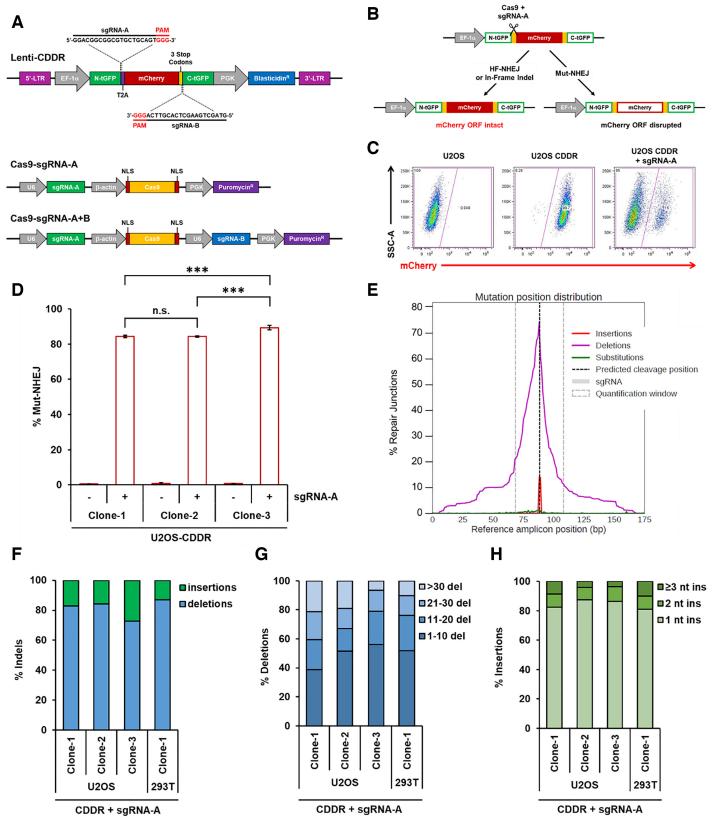Cas9 Stable Cell Line - U2OS
Cat.No. : CSC-RO0177 Host Cell: U2OS
Size: >1x10^6 cells/vial Validation: T7 Endonuclease I assay
Cat.No. : CSC-RO0177 Host Cell: U2OS
Size: >1x10^6 cells/vial Validation: T7 Endonuclease I assay
| Cat. No. | CSC-RO0177 |
| Product Type | Cas9 overexpression stable cell line |
| Introduction | Clustered regularly interspaced palindromic repeats (CRISPR)/Cas9 is a gene-editing technology that contains two essential components: a guide RNA (gRNA) to match a target gene, and the Cas9 (CRISPR-associated protein 9) endonuclease which causes a double-stranded DNA break, allowing modifications to the genome via nonhomologous end joining (NHEJ) or homology-directed repair (HDR). |
| Cell Line Information | U2OS-Cas9 cell line is engineered to stably overexpress Cas9 nuclease. The Cas9 nuclease in U2OS-Cas9 cell line has been functionally validated using T7 Endonuclease I assay. In combination with separately transfected sgRNAs, U2OS-Cas9 cell line can be used to efficiently generate targeted genomic modifications including gene knockout, gene knockin, gene mutagenesis, gene tagging etc. It is also an ideal cell line model for sgRNA screening and validation, either individually or in pools. |
| Target Gene | Cas9 |
| Host Cell | U2OS |
| Applications | 1) CRISPR genome editing, such as gene knockout (KO), gene knockin (KI), gene mutagenesis, gene tagging etc. 2) High-throughput sgRNA screening and validation |
| Quality Control | 1) T7E1 assay 2) Mycoplasma detection |
| Size Form | One vial of frozen cells, typically >1x10^6 cells/vial |
| Shipping | Dry ice |
| Storage | Liquid nitrogen |
| Species | Homo sapiens (Human) |
| Mycoplasma | Negative |
| Format | One frozen vial containing millions of cells |
| Storage | Liquid nitrogen |
| Safety Considerations |
The following safety precautions should be observed. 1. Use pipette aids to prevent ingestion and keep aerosols down to a minimum. 2. No eating, drinking or smoking while handling the stable line. 3. Wash hands after handling the stable line and before leaving the lab. 4. Decontaminate work surface with disinfectant or 70% ethanol before and after working with stable cells. 5. All waste should be considered hazardous. 6. Dispose of all liquid waste after each experiment and treat with bleach. |
| Ship | Dry ice |
DNA double-strand breaks (DSBs) are the most severe type of DNA damage, causing chromosomal translocations, genomic instability, and cell death. The researchers created the CDDR (CRISPR-Cas9-based Dual-fluorescent DSB Repair) assay to precisely detect and quantify DSB repair outcomes in mammalian cells. CDDR can discriminate between high-fidelity (HF), error-prone non-homologous end-joining (NHEJ), and homology-directed repair (HDR) by inserting one or two DSBs into an intrachromosomal fluorescent reporter with Cas9 and sgRNAs. CDDR demonstrated that HF-NHEJ is dependent on DNA Ligase IV, XRCC4, and XLF and that deleting these genes promotes HDR and error-prone end-joining. The deletion of the ATM kinase boosted HF-NHEJ and decreased HDR, demonstrating CDDR's value in researching DSB repair mechanisms.
 Figure 1. Using the CDDR reporter assay, the researchers identify and assess DSB repair. Cas9-sgRNA-expressing plasmid transfections in U2OS-CDDR cells are followed by FACS analysis to determine Mut-NHEJ repair efficiency. (Eki R, et al., 2023)
Figure 1. Using the CDDR reporter assay, the researchers identify and assess DSB repair. Cas9-sgRNA-expressing plasmid transfections in U2OS-CDDR cells are followed by FACS analysis to determine Mut-NHEJ repair efficiency. (Eki R, et al., 2023)
Enhance your genome editing research with Creative Biogene's Cas9 Stable Cell Line-U2OS. Our stable cell line offers reliable and consistent Cas9 expression, ensuring efficient genome editing without the variability associated with transient transfection. By utilizing this advanced tool, researchers can streamline the generation of U2OS-CDDR cells with precise deletions in DNA repair genes, accelerating studies on DNA double-strand break repair mechanisms. Experience enhanced efficiency, reproducibility, and cost-effectiveness in your experiments with Creative Biogene's Cas9 Stable Cell Line-U2OS, your partner in cutting-edge genetic research.

Our promise to you:
Guaranteed product quality, expert customer support.
 24x7 CUSTOMER SERVICE
24x7 CUSTOMER SERVICE
 CONTACT US TO ORDER
CONTACT US TO ORDER